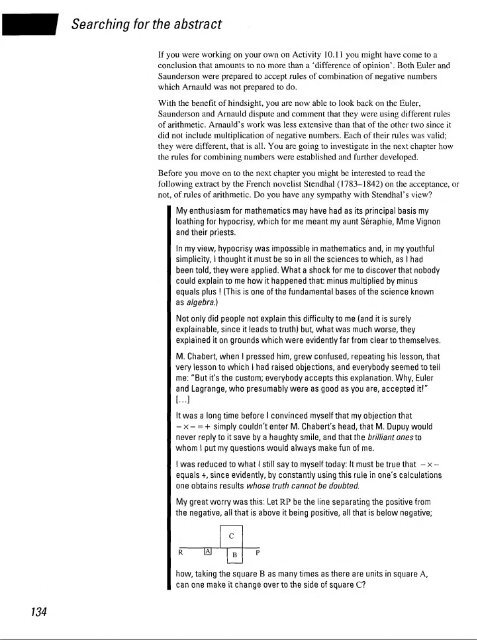history of mathematics - National STEM Centre
history of mathematics - National STEM Centre
history of mathematics - National STEM Centre
You also want an ePaper? Increase the reach of your titles
YUMPU automatically turns print PDFs into web optimized ePapers that Google loves.
134<br />
Searching for the abstract<br />
If you were working on your own on Activity 10.11 you might have come to a<br />
conclusion that amounts to no more than a 'difference <strong>of</strong> opinion'. Both Euler and<br />
Saunderson were prepared to accept rules <strong>of</strong> combination <strong>of</strong> negative numbers<br />
which Arnauld was not prepared to do.<br />
With the benefit <strong>of</strong> hindsight, you are now able to look back on the Euler,<br />
Saunderson and Arnauld dispute and comment that they were using different rules<br />
<strong>of</strong> arithmetic. Arnauld's work was less extensive than that <strong>of</strong> the other two since it<br />
did not include multiplication <strong>of</strong> negative numbers. Each <strong>of</strong> their rules was valid;<br />
they were different, that is all. You are going to investigate in the next chapter how<br />
the rules for combining numbers were established and further developed.<br />
Before you move on to the next chapter you might be interested to read the<br />
following extract by the French novelist Stendhal (1783-1842) on the acceptance, or<br />
not, <strong>of</strong> rules <strong>of</strong> arithmetic. Do you have any sympathy with Stendhal's view?<br />
My enthusiasm for <strong>mathematics</strong> may have had as its principal basis my<br />
loathing for hypocrisy, which for me meant my aunt Seraphie, Mme Vignon<br />
and their priests.<br />
In my view, hypocrisy was impossible in <strong>mathematics</strong> and, in my youthful<br />
simplicity, I thought it must be so in all the sciences to which, as I had<br />
been told, they were applied. What a shock for me to discover that nobody<br />
could explain to me how it happened that: minus multiplied by minus<br />
equals plus ! (This is one <strong>of</strong> the fundamental bases <strong>of</strong> the science known<br />
as algebra.)<br />
Not only did people not explain this difficulty to me (and it is surely<br />
explainable, since it leads to truth) but, what was much worse, they<br />
explained it on grounds which were evidently far from clear to themselves.<br />
M. Chabert, when I pressed him, grew confused, repeating his lesson, that<br />
very lesson to which I had raised objections, and everybody seemed to tell<br />
me: "But it's the custom; everybody accepts this explanation. Why, Euler<br />
and Lagrange, who presumably were as good as you are, accepted it!"<br />
[...]<br />
It was a long time before I convinced myself that my objection that<br />
- x - = + simply couldn't enter M. Chabert's head, that M. Dupuy would<br />
never reply to it save by a haughty smile, and thatthe brilliant onesto<br />
whom 1 put my questions would always make fun <strong>of</strong> me.<br />
I was reduced to what I still say to myself today: It must be true that - x -<br />
equals +, since evidently, by constantly using this rule in one's calculations<br />
one obtains results whose truth cannot be doubted.<br />
My great worry was this: Let RP be the line separating the positive from<br />
the negative, all that is above it being positive, all that is below negative;<br />
TAT<br />
how, taking the squares as many times as there are units in square A,<br />
can one make it change over to the side <strong>of</strong> square C?
















